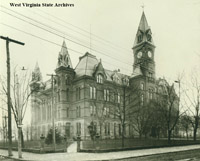

Chapter Three |
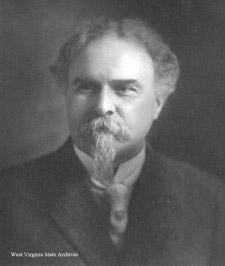 Governor William A. MacCorkle
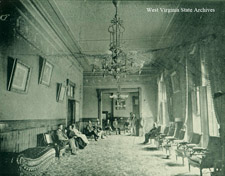 Governor's Reception Room |
The inauguration on March 4, 1893, began with a procession of carriages from Gov. Aretas Brooks Fleming's residence on Washington Street to the capitol, accompanied by the Second Regiment band and military escort from Huntington. Fleming, incoming governor William A. MacCorkle, and other incoming and outgoing officials rode in the carriages. Because of the bad weather, the inaugural ceremonies were moved inside to the Senate Chamber. MacCorkle gave his inaugural speech from the Senate President's stand and then was administered the oath of office. MacCorkle had a reception in the capitol reception room following the ceremonies.
 |
 Schedule for MacCorkle's Inauguration
|
 Inaugural Invitation |
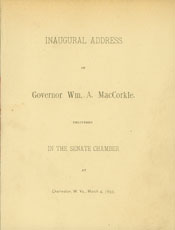 Title page of MacCorkle's |
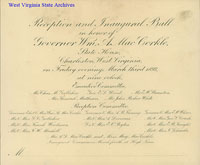 Inaugural Ball Invitation |
A first, MacCorkle held his reception and inaugural ball the night before the inauguration. The reception was held in the State Library, while the ball took place in the Senate Chamber, "lasting till after four o'clock" in the morning. The furniture had been removed from the Senate and canvas laid over the carpet for the dancing, which consisted of eighteen dances. MacCorkle, "youthful and beaming," and his wife received from 600 to 800 people while Jacoby's Orchestra played a program of music. Supper was provided at 11:00 p.m.
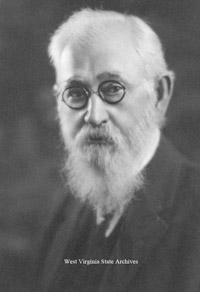 Governor George W. Atkinson |
Four years later, MacCorkle's successor, George Wesley Atkinson, was inaugurated on the steps on the west side of the capitol. After the Rev. Dr. A. B. Riker of the State Street Methodist Episcopal Church offered the prayer, retiring governor William MacCorkle introduced the incoming governor. According to the Charleston newspapers, the oath of office was administered to Atkinson prior to his inaugural address, a change of order from prior inaugurals. (The Wheeling Intelligencer listed the oath after the address.)
An informal reception was held in the governor's reception room until 2:00 p.m., at which time Atkinson, MacCorkle, and invitees moved to a reviewing stand on the Capitol Street side of the capitol to watch a parade. Headed by the Elkins Cadets from Wheeling, the parade marched from Kanawha Street out Capitol Street to Washington, around the capitol, and then down Capitol to Kanawha. This was something new for gubernatorial inaugurations, as previous ceremonies had involved a procession of the incoming and outgoing officers to the place of inauguration, rather than a post-ceremony parade at which the governor was a spectator rather than participant. |
|
|
"For over an hour the rockets in countless numbers and endless variety tore their way heavenward and bursting, rivaled the very stars in their dazzling beauty and magnificance.
And to crown their almost phenomenal exhibit, a picture of Governor Atkinson framed in a frame of blazing glory and flooded with golden light was thrown on the still night, and the crowded, surging mass of humanity surrounding the square broke out in a shout that shook the earth." | In the evening, fireworks were displayed in a lot opposite the capitol building. Afterwards, a reception was held in the House of Delegates from 9:30 to 10:30, with Governor Atkinson, who was a widower at the time, with his eldest daughter Bessie; ex-Governor MacCorkle and his wife; and the Hon. W. M. O. Dawson, escorting Atkinson's second daughter Florence, among those in the receiving line. Ewart's and Jacoby's orchestras combined to provide music for the inaugural ball in the Senate. A five-course meal was served in the Supreme Court. The decorations in the various capitol rooms, "the finest ever seen in Charleston," were the work of a professional designer from Cincinnati who carried out his plan despite conflict with Governor MacCorkle. |
"The big clock in the tower was tolling the witching hour of four and dawn just breaking when the unwelcome strains of Home Sweet Home announced the close of the grandest ball ever held in the State of West Virginia." - Charleston Daily Gazette, March 5, 1897 |
 Governor Albert B. White |
March 4, 1901, provided a downpour for the inauguration of Albert Blakeslee White. The occasion began with a procession of the governor, governor-elect, the White Marching Club and Citizens' Band of Parkersburg, a company of National Guard, and various state officials from the Ruffner Hotel to the capitol. The ceremony took place on the Capitol Street side of the building and involved the usual elements: address by Governor Atkinson, inaugural address by White, and administeration of the oath of office. The reception was held in the governor's room, a more formal reception that evening in the House of Delegates, the ball in the Senate with music provided by the Burlew Opera House Orchestra, and the supper in the Supreme Court. |
 Ruffner Hotel |
William M. O. Dawson's inaugural activities began with a reception and ball held the night before the inauguration, with the reception held in the governor's reception rooms and the ball held again in the Senate, accompanied by the Burlew Opera House Orchestra. The Ladies Aid Society of St. John's Episcopal Church prepared the supper, which was served in the House of Delegates.
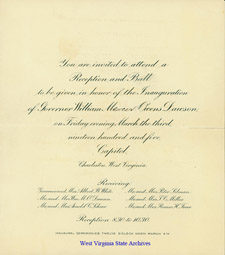 Invitation to Dawson's reception |
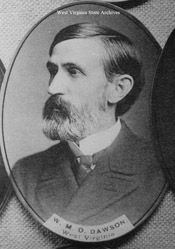 Governor William M. O. Dawson On March 4, a procession of mounted police, Chief Marshal N. S. Burlew, the Second Regiment Band, a battalion of National Guard, and carriages of various officials, which had assembled near the Capitol Annex, processed up Lee Street to Dawson's residence. Dawson joined Governor White and former governors Atkinson and MacCorkle in the first carriage, and the group processed to the capitol. Inaugural ceremonies were held in the House of Delegates and opened with the playing of "America." Remarks by MacCorkle, Atkinson, and White preceded the inaugural address of Dawson. Judge Brannon of the Supreme Court administered the oath of office. A reception in the governor's reception room followed. |
 Governor William E. Glasscock
|
The inauguration of William E. Glasscock began with a procession comprised of many of the same elements as had been part of the inauguration four years earlier: mounted police, Chief Marshal N. S. Burlew, the Second Regiment Band, a battalion of National Guard, and carriages of various officials. This time, Governor Dawson and four former governors, Fleming, MacCorkle, Atkinson, and White, participated in the procession. Assembling in front of the capitol on Lee Street, the procession marched to Broad, out to Kanawha, and west on Kanawha to the Kanawha Hotel (corner Kanawha and Summers),
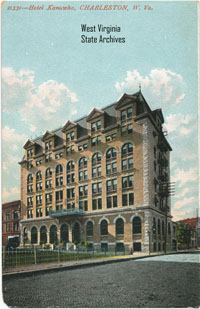 Hotel Kanawha. where William Glasscock joined the group. Continuing an elaborate route, the procession moved north to Washington, back to Broad, then to Lee and Capitol, arriving at the capitol. |
The inaugural ceremonies were held in the House of Delegates, with Dawson presiding, and consisted of an invocation of Glasscock's pastor Dr. Charles K. Jenness of Morgantown; remarks from former governors MacCorkle, Atkinson, and White; the inaugural address of Glasscock; and administration of the oath of office by Judge Ira Robinson. A reception was held in the governor's reception room, and a ball was held in the Senate in the evening, with supper again served in the House of Delegates by the Ladies Aid Society of St. John's.
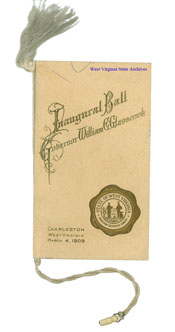 Dance card for Glasscock's |

